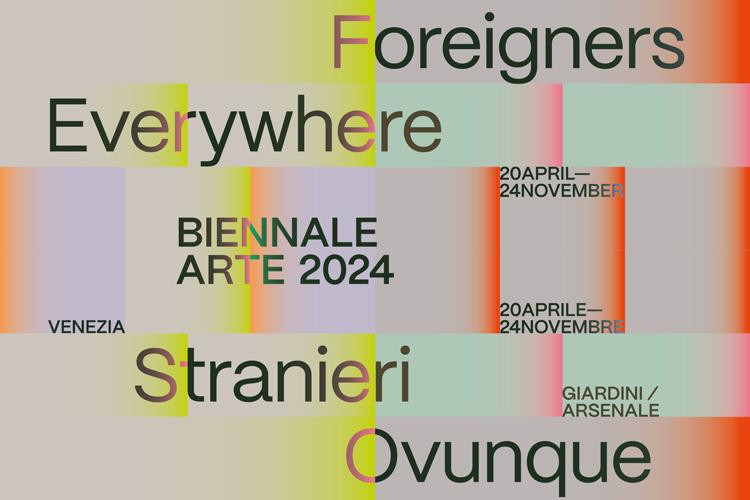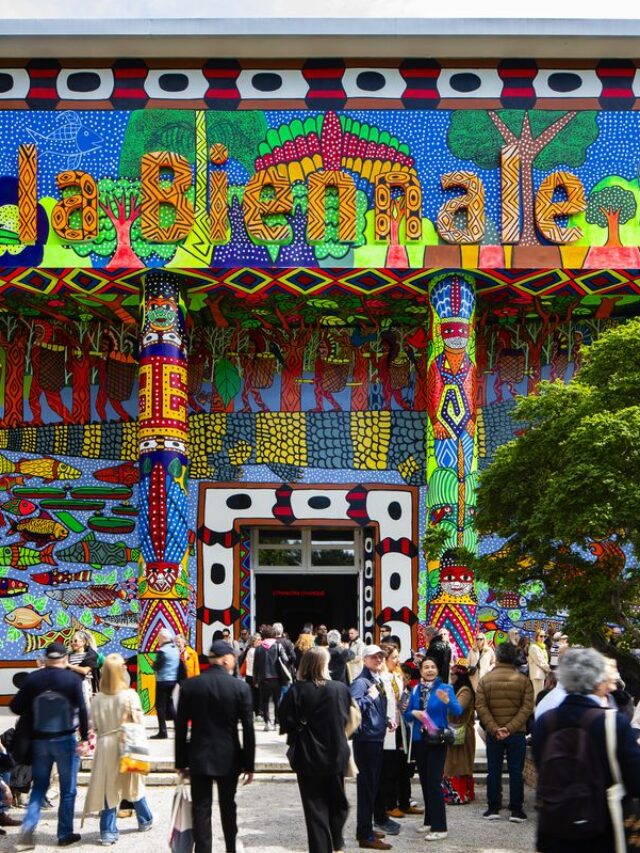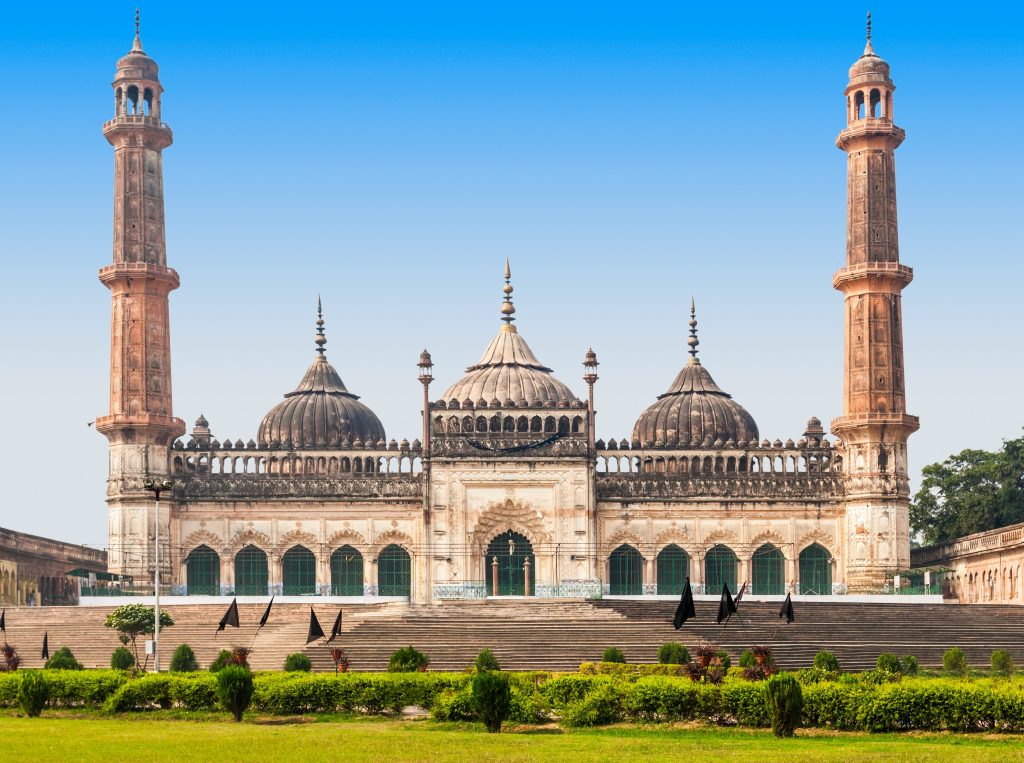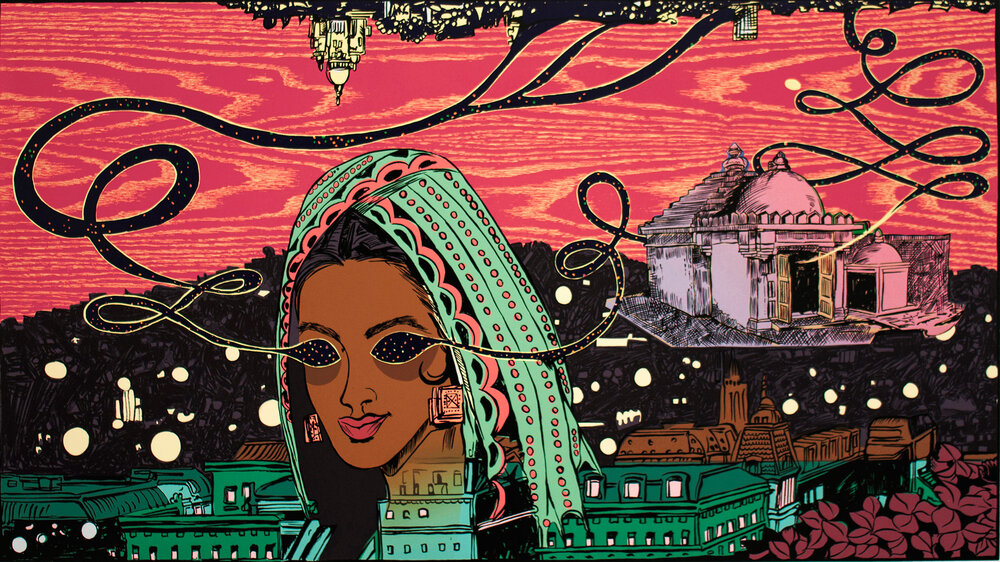Under the curatorship of Adriano Pedrosa, the theme “Foreigners Everywhere” casts a wide net, drawing in stories of nationalism, displacement, and colonialism. It’s a theme that dances on the edges of history, inviting reflection and dialogue.
As you stroll through the pavilions, each one tells a story. In the Dutch Pavilion, the echoes of colonial art theft reverberate. But here, there’s action, not just reflection. A wooden statue, long held in a distant museum, finds its way back to the Congo if only for a moment, sparking conversations about restitution and justice. Step into the Australia Pavilion, and you’re met with a striking installation by First Nations artist Archie Moore. His genealogical chart, marked by gaps and silences, speaks volumes about the traumatic history of Indigenous Australians, shedding light on narratives often overlooked. But it’s not just about confronting the past; it’s about challenging the present. Some pavilions play with the idea of borders, blurring the lines between here and there, us and them. They invite you to question the rigidity of boundaries and the meaning of belonging. And amidst it all, there’s a shift—a turning of the spotlight. The global south, long relegated to the sidelines of the art world, steps into the limelight. With Pedrosa at the helm, there’s a palpable emphasis on representation and visibility, a celebration of voices too long ignored. In the labyrinth of art and ideas, the 60th Venice Biennale is a beacon—a reminder that art has the power to provoke, challenge, and ultimately unite.
The Central Pavilion

Once a bastion of Western art, its white walls burst forth with colour, a testament to the power of transformation. The mural, a tapestry of hues, is the creation of MAHKU, a collective of painters from the Brazilian Amazon. Their art, born not of convention but of miração—visionary experiences sparked by ayahuasca rituals—defies the rules of Western technique. As you approach, the mural unfolds before you, a kaleidoscope of mythical tales and ancestral wisdom. Each brushstroke tells a story, weaving together threads of tradition and innovation into a mesmerizing tapestry—step inside, and you’re greeted by a gallery unlike any other. Here, ‘outsider’ artists take centre stage, their voices resonating through the halls of the Biennale for the first time. Each piece speaks of journeys untold, dreams unleashed, and boundaries shattered. In this space where the past meets the present, where tradition meets innovation, the Central Pavilion stands as a testament to the power of art to transcend boundaries and ignite the imagination. And as you wander its halls, you can’t help but feel the pulse of creativity, beating with the rhythm of countless stories waiting to be told.
Cosmic Garden, Salone Verde

Step into the ethereal realm of the Salone Verde, where the air is alive with the whispers of ancient Indian myths and the vibrant hues of embroidered tapestries dance before your eyes. Here, amidst the hallowed halls, the collateral exhibition “Cosmic Garden” unfolds like a mystical journey into the heart of Indian artistry. It’s a place where the boundaries between myth and reality blur, and the stories of gods and goddesses come to life in breathtaking detail.
As you wander through the rooms, you’re greeted by a symphony of colours and textures, each piece a testament to the rich tapestry of Indian culture. Paintings by acclaimed artists Madhvi Parekh and Manu Parekh adorn the walls, their brushstrokes weaving tales of ancient wisdom and esoteric Vedic symbols.
But it’s not just paintings that adorn this sacred space. Alongside the canvases, colossal embroidery panels stand as monuments to the timeless artistry of Karishma Swali and the Chanakya School of Craft. Through intricate stitches and vibrant threads, they breathe new life into age-old traditions, reimagining ancient myths and legends in a stunning display of creativity. “The project seeks to re-evaluate the mutual relationship between women and embroidery, transcending the confines of domesticity and bringing hand-embroidery into the public sphere,” the curators explain, their words echoing through the halls like a gentle mantra.
As you immerse yourself in the whimsical world of “Cosmic Garden,” you’re transported to a realm where deities with multi-limbed forms and metamorphosed beings dance across fabric and canvas alike. It’s a world of boundless imagination and untamed energy, where every stitch and brushstroke tells a story of divine beauty and eternal grace. In the embrace of the Salone Verde, time seems to stand still, allowing you to lose yourself in the mesmerizing tapestry of Indian artistry. It’s a journey of discovery and wonder, where the boundaries between the seen and the unseen fade away, leaving only the magic of the Cosmic Garden to guide your way.
Historical and Contemporary Core, Arsenale
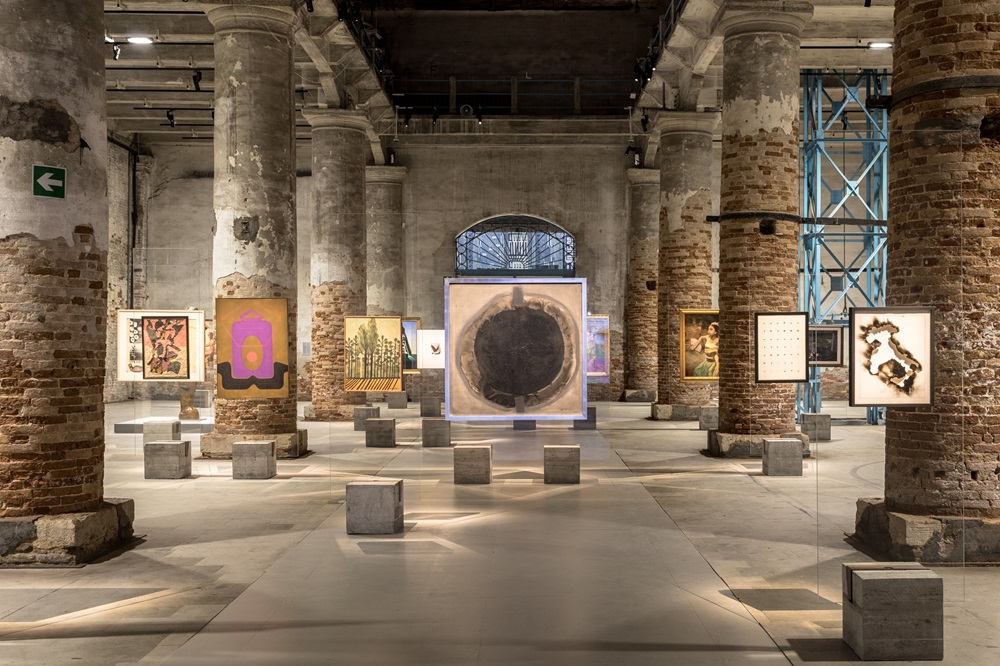
In the depths of the Arsenale, where history whispers through the ancient walls, a new narrative unfolds—a celebration of textile art from the global south, where threads become the medium of expression. Step into the halls, and you’re enveloped in a world of colour and texture. Here, embroidery, felt, dye, and stitches reign supreme, challenging the boundaries of traditional fine arts. Every corner holds a story, every stitch a tale waiting to be told. Artists, perhaps unfamiliar with the museum scene, unveil their pictorial visions through fabric and thread, their creations a testament to the power of art to transcend boundaries. Amidst this tapestry of creativity, one piece stands out—a vast embroidered canvas by the Bordadora de Isla Negra. Created by self-taught women from a coastal village in Chile, it vividly captures the essence of daily life, transporting you to another time and place. Nearby, Pacita Abad’s trapunto works beckon with their painted and stitched cloth. Born in the Philippines, her art speaks of the immigrant experience, portraying stories of hope and struggle with poignant clarity.”Haitians Waiting At Guantanamo Bay” (1994) evokes the longing of those trapped behind barbed wires, while “Blend in Before You Stand Out” (1995) tells the tale of immigrants striving to find their place in a new society. As you wander through this textile wonderland, you can’t help but marvel at the beauty of each piece, the stories they tell, and the worlds they conjure. And in that moment, you realize that art knows no bounds—it transcends language, culture, and tradition, weaving us all together in a tapestry of shared humanity.
Australia Pavilion, Giardini
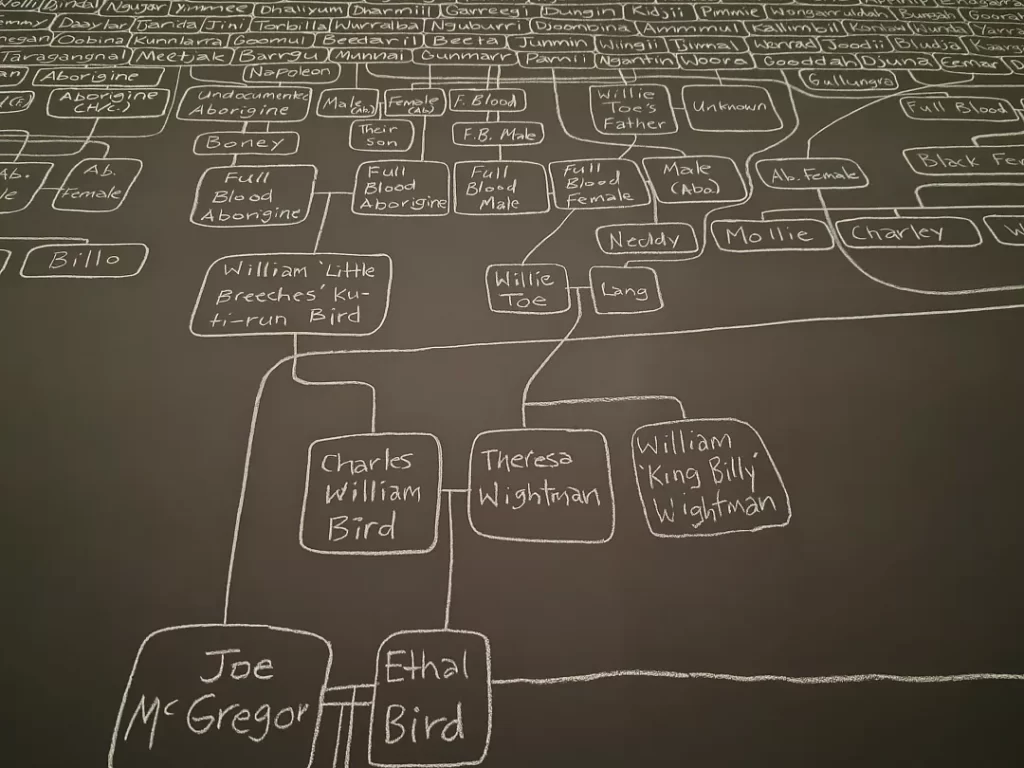
Stepping from the warm embrace of sunlight into the shadowy depths of the Australia pavilion, your eyes adjust slowly to the dimness. The painted, solemn black walls hold a secret waiting to be revealed.
As your gaze settles on the walls, a dense white chalk diagram emerges, sprawling across all four sides of the pavilion. It’s a genealogical chart meticulously tracing the ancestral lines of First Nations artist Archie Moore—his Kamilaroi, Bigambul, and British heritage stretching back an astonishing 65,000 years. But this is no ordinary family tree. “Kith and Kin” is a tribute to Australian Indigenous lineage and interconnectedness, yet it also unveils a painful past marred by trauma.
In the place of names, you find racial slurs etched into the boxes, reminders of a history stained by prejudice. Details of blood purity and caste fill the spaces, casting a stark light on the injustices of the past. And amidst it all are the voids—the empty spaces representing lives lost, erased, or forgotten. In the heart of the pavilion, a central table stands piled high with documents—evidence of redacted coroners’ inquiries into the deaths of Indigenous Australians within state prisons. It’s a poignant reminder of the ongoing struggle for justice and recognition.
Standing in this powerful and sobering space, you can’t help but feel the weight of history pressing down upon you. It’s a place of reflection, reckoning with the past and honouring those who came before. And as you take it all in, you understand why “Kith and Kin” earned the Golden Lion Award for Best National Participation. It’s more than just an exhibition—it’s a testament to resilience, a call for justice, and a beacon of hope for the future.
Germany pavilion, Giardini
Amidst the bustling chaos of the press preview days at the Venice Biennale, a buzz surrounds the German pavilion that draws long queues of eager visitors. It’s quickly gaining a reputation as a must-see attraction, and for good reason. “Thresholds,” the exhibition housed within the pavilion, promises a wacky and destabilising experience—a perfect fit for the Biennale crowd hungry for something unconventional.
Inside, the works of artists like Michael Akstaller, Yael Bartana, and Robert Lippok take centre stage, offering a thought-provoking exploration of boundaries in all their forms. But what sets this pavilion apart is its bold move beyond the confines of the Giardini. For the first time, the installation spills onto the neighbouring island of La Certosa, inviting visitors to embark on a journey beyond the ordinary.
It’s a symbolic gesture—one that challenges the very notion of nationhood, especially given the pavilion’s fraught history and fascist architecture. There’s a sense of anticipation as whispers of Mondtag’s captivating performance echo through the pavilion. His dust-coated, embattled presence seems to captivate audiences, stealing the spotlight and leaving a lasting impression. However, whether visitors will venture to La Certosa remains to be seen. All eyes are now on the German pavilion, where boundaries are blurred, expectations are shattered, and art takes centre stage in all its glorious complexity.
Lebanon Pavilion, Arsenale
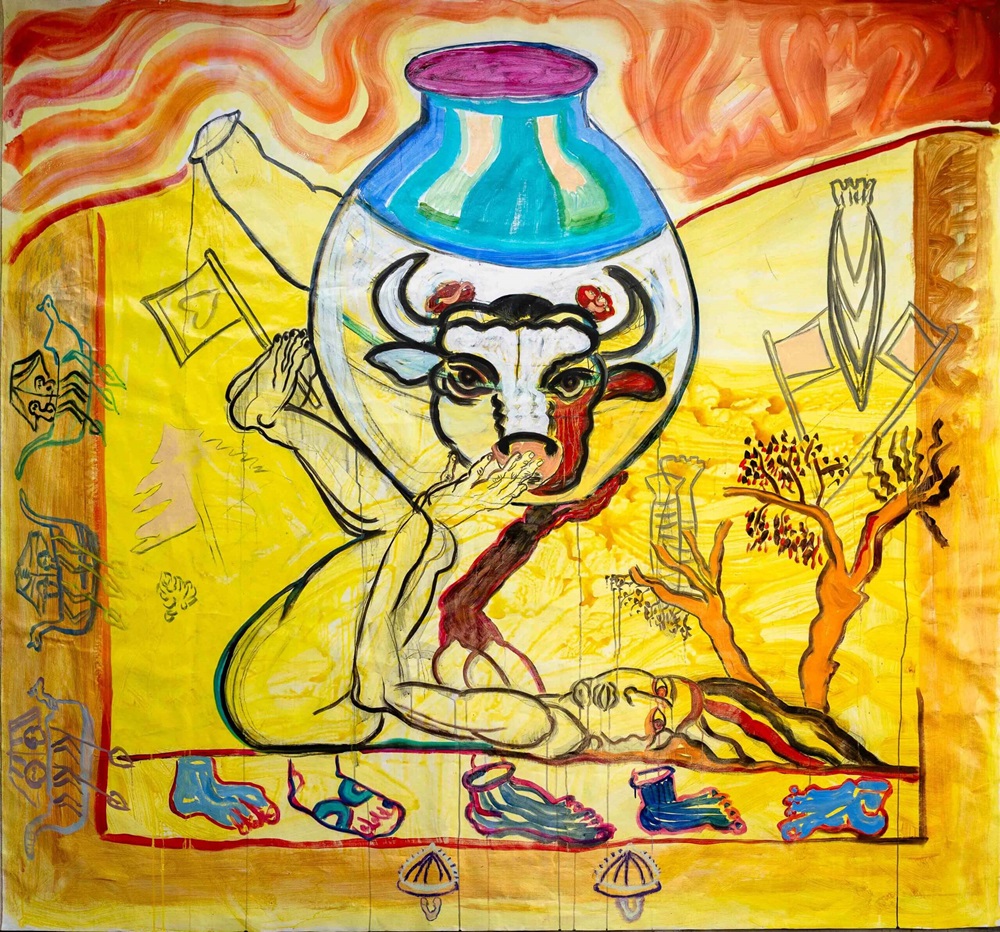
In the heart of the Venice Biennale, amidst a sea of artistic expression, lies Lebanon’s pavilion—a beacon of defiance against long-standing Western narratives. Within the walls of “A Dance with Her Myth,” artist Mounira AI Solh weaves a tale that challenges tradition and reshapes history. Drawing inspiration from the ancient myth of Europa and the bull, AI Solh dares to reimagine the story from a different perspective.
In her rendition, Europa is no longer a passive figure but a force to be reckoned with—a woman who defies expectations and takes control of her narrative. Instead of succumbing to Zeus’s advances, she boldly asserts her agency, flipping the power dynamic on its head. The pavilion’s centrepiece is a boat—a vessel of liberation that invites visitors to embark on a symbolic journey of empowerment. Adorned with imagery and symbolism, it is a tangible representation of AI Solh’s vision of emancipation.
Projected onto the boat’s sail is a mesmerizing 12-minute film—a visual poem that captures the essence of AI Solh’s reinterpretation. Here, the goddess spins an urn containing a bull’s head while poetic verses echo her defiance and determination. “I looked for a magnificent white bull… but all I found was a goat,” reads a line from the poetry—a poignant reminder of the artist’s quest to reclaim and redefine her story.
In an interview with pavilion curator Nada Ghandour, AI Solh speaks passionately about her mission. “We, as women, do not want to play the role of victims,” she declares. “We need to take back our stories, colour them, change them, reverse them, turn them around, to reappropriate them. And so, within the confines of the Lebanon pavilion, a new narrative unfolds—one of strength, resilience, and the unyielding spirit of defiance. It’s a story that challenges conventions, inspires change, and reminds us of the power of storytelling to shape our collective destiny.
Romania pavilion, Giardini

Step into the Romania pavilion at the Venice Biennale, where the air hums with the subtle energy of artistic contemplation. Beneath the title “What Work Is,” the space comes alive with the evocative works of Sarban Savu and the Atelier Brenda, represented by the talented designers Nana Esi and Sophie Keij.
As you cross the threshold into this luminous concrete sanctuary, your senses are immediately drawn to the walls adorned with paintings that seem to breathe life. Reminiscent of social realism but bathed in delicate pastel hues, these artworks beckon you closer, inviting you to delve into their hidden depths.
Upon closer inspection, the scenes depicted within these captivating canvases reveal a poignant narrative. Instead of bustling labourers toiling away, you find moments of quiet repose—scenes populated by disoriented protagonists and lethargic extras. Amidst the backdrop of an oddly empty construction site, men in hard caps perch on improvised stools, their weary eyes betraying a sense of longing for home. Nearby, a museum attendant steals a moment of respite, drifting into a peaceful slumber before a medieval altarpiece.
These poignant vignettes reflect the profound emotions of displacement and homesickness often accompanying migratory work. Through their art, Savu and the Atelier Brenda offer a glimpse into the hidden struggles and quiet moments of solitude experienced by those far from home. In the calm confines of the Romania pavilion, every stroke of paint tells a story of longing, resilience, and the enduring human spirit in the face of adversity. It’s a tale that resonates with visitors, stirring hearts and sparking conversations that echo long after they leave its sacred halls.

Jain Syriac Babu is a Kerala-born, Italy-based theatre artist and art enthusiast.


